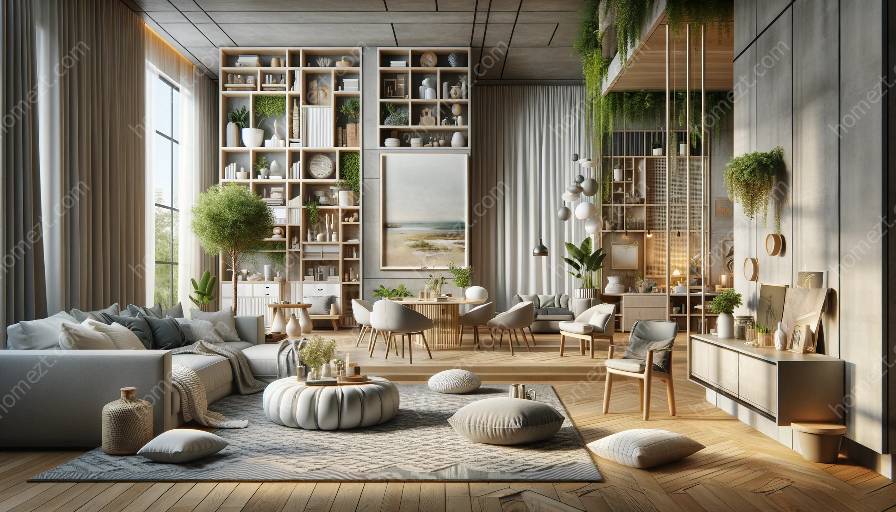Sustainable design and space planning play a crucial role in creating environmentally-friendly and functional interior spaces. In interior design, sustainable design principles inform space planning decisions to optimize the use of space while minimizing negative impacts on the environment. This article explores the relationship between sustainable design, space planning, and interior styling, highlighting the integration of sustainable practices to enhance the overall quality and functionality of interior spaces.
The Intersection of Sustainable Design and Space Planning
Sustainable design emphasizes the use of environmentally-friendly materials, energy-efficient solutions, and responsible resource management. When applied to space planning in interior design, sustainable design principles align with the goal of maximizing spatial efficiency, minimizing waste, and creating healthy living and working environments. This intersection involves considering factors such as natural lighting, ventilation, and the use of sustainable materials to enhance the overall functionality and aesthetics of interior spaces.
Efficient Space Utilization
One of the key aspects of sustainable design in space planning is efficient space utilization. Interior designers strive to optimize space by carefully considering the layout, flow, and functionality of each area within a given space. Sustainable space planning involves minimizing the use of non-renewable resources, reducing energy consumption, and incorporating multi-functional furniture and storage solutions to maximize the use of available space.
Integration of Sustainable Materials and Technologies
Sustainable interior design integrates eco-friendly materials and technologies to reduce environmental impact and promote sustainable living. Space planning decisions are influenced by the selection of sustainable materials such as bamboo, recycled wood, low-emission paints, and energy-efficient lighting. The incorporation of sustainable technologies, such as smart home systems and renewable energy sources, further enhances the eco-friendly aspect of space planning in interior design.
Optimizing Space for Sustainability
Optimizing space for sustainability involves strategic planning and mindful consideration of environmental impact. Interior designers collaborate on space planning decisions to create functional and aesthetically pleasing interiors that prioritize sustainable practices. This includes considering the positioning of windows for natural ventilation, maximizing natural light to reduce the need for artificial lighting, and selecting materials with low environmental impact for flooring, walls, and furnishings.
Biophilic Design Integration
Biophilic design, which incorporates natural elements and patterns into interior spaces, is an integral part of sustainable space planning. By introducing elements such as indoor plants, natural textures, and organic shapes, interior designers enhance the visual appeal while fostering a connection to nature within the built environment. This approach contributes to creating healthier and more sustainable interior spaces.
Adaptive Reuse and Sustainable Renovation
Another aspect of sustainable design influencing space planning is the concept of adaptive reuse and sustainable renovation. Interior designers focus on repurposing existing structures and materials, minimizing demolition and waste generation. By incorporating sustainable renovation practices into space planning, designers can transform spaces into functional and environmentally-responsible environments, reducing the overall ecological footprint of interior design projects.
Blending Sustainable Design with Interior Styling
Sustainable design principles go hand-in-hand with interior styling to create visually appealing and environmentally-conscious spaces. By integrating sustainable elements into interior styling, designers can achieve a harmonious balance between aesthetics and environmental responsibility.
Sustainable Material Palette and Aesthetics
When making space planning decisions, interior designers consider the use of sustainable material palettes and aesthetics to create visually striking interiors. The incorporation of natural and recyclable materials, coupled with thoughtful color schemes and textures, contributes to the overall appeal of the space while promoting sustainability. Sustainable material choices are carefully integrated into the space planning process to ensure a cohesive and environmentally-responsible design aesthetic.
Energy-Efficient Lighting and Fixtures
Space planning decisions in interior design often involve the selection and placement of energy-efficient lighting and fixtures. By strategically integrating sustainable lighting solutions and fixtures, designers enhance the ambiance of the space while reducing energy consumption and minimizing environmental impact. This careful consideration of lighting and fixtures is an essential component of sustainable space planning and optimization.
Conclusion
Sustainable design serves as a guiding principle in informing space planning decisions in interior design, contributing to the creation of eco-friendly, functional, and visually appealing spaces. By integrating sustainable practices, materials, and technologies, interior designers optimize space for sustainability while enhancing the overall functionality and aesthetics of interior spaces. The blend of sustainable design, space planning, and interior styling results in impactful and environmentally-conscious design solutions, reflecting a commitment to creating spaces that prioritize the well-being of occupants and the planet.


























